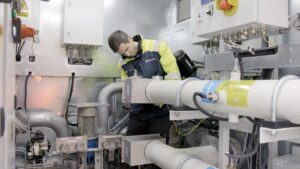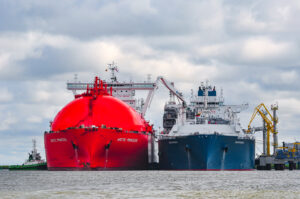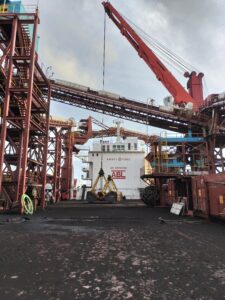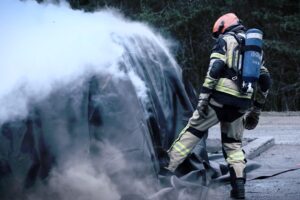In 2035 the sale of new petrol and diesel cars will end in EU countries. While it means cleaner road transport in Europe, it adds new risks for ship operators as a rich mix of fuels and batteries will be onboard ro-ro’s and ropax vessels.
by Craig Eason
There is a tendency to view these alternative fuelled vehicles as a greater risk, notably due to thermal runaway of lithium ion battery fires, and with hundreds of EVs and petrol cars being packed tightly onto enclosed ro-ro decks one can understand the concern in the industry. How does one fight a fire which could be electric, explosive, and volatile? Part of the answer to this question came last week in the conclusion of the LASH fire project.
Retraining the trained
Most people, those who have no idea about the shipping industry but even those working in it, may not realise that ships’ crews are trained firefighters. They may not be trained to the level of firefighters ashore, but they will all have gone through intensive firefighting courses, as well as first-response first-aid courses as part of their training to become seafarers.
Afterall if a ship catches fire there’s no to com to your help with lights flashing and sirens wailing. The crew need to be able to know what they can do, and just as importantly know what they can not do.
As shipping is changing, evolving with the new fuels and new cargoes, it is becoming clear that crew training has to also evolve. As the methanol orderbook increases they need to know about the risks of methanol, just as those onboard LNG fuelled vessels need to understand that fuels properties and risks.
The same is going to be true with cargo evolution. Tanker crews will have their dangerous cargo endorsement, a certificate that forms part of the list of requirements from vetting companies and charters for example, but what if the risks are not that clear because knowledge gaps exist.
The mix of cars being carried on PCTC’s as well as on ro-pax vessels is changing. There’s three types of electric vehicles: the Pure EVs which are powered by batteries alone, the plug-in hybrid EV (PHEV) which will also have a diesel or petrol engine and the Hydrogen fuel cell EV (FCEV) The FCEV does not require recharging, but will need hydrogen tanks, but is still classed as an EV as it has a battery and the fuel cell generates electricity.
on-off about onboard charging
There are no fixed rules on the carriage of electric or hybrid cars on vessels, with speculation that the IMO’s Marine Safety Committee will have to respond to this very soon. As a result there are different approaches being taken to the risks.
One Norwegian coastal ferry operator has been reported as banning EV’s onboard, which made the news because Norway is a leading user of EVs, while other companies allow them, but will not allow charging. One European ferry operator even allows charging.
EVs on fire on board make headlines, even if they may not be the cause of the fire

When the car carrier Felicity Ace caught fire in February 2022 fingers quickly pointed to brand new EVs onboard and the potential of battery fires and thermal runaway. The truth was never discovered as the vessel eventually sank while under tow, but experts believe any roro and PCTC fire remains hard to tackle because of the closeness, and inaccessibility, of the cargo.
LASH
One EU-backed project that is currently coming to a close, has been instrumental on assessing fire risks on car carriers, whether ro-pax, ro-ro or PCTC of this changing constellation of vehicles.
LASH Fire is one of the largest maritime fire and safety projects in Europe and consists of a consortium of 22 companies and organisations. It follows on from other similar projects such as the Danish DBI ELBAS project. The LASH project has been led by the Research Institute of Sweden (RI.SE) with Stena and DFDS taking part. The overall aim has been to improve understanding in the industry of changing fire risks due to this changing mix of roll on roll off cargo and how they could be responded to by ships’ crews.
The increase in electric and hybrid vehicle orders has created a unique challenge for passenger vessel operators. As society takes its responsibilities to go green more seriously there has been a hug increase in the number of electric cars on the roads, and this has been reflected onboard ships as well, whether passenger ships or car carriers.
Experts within the LASH project believe that the risks posed by electric vehicles are no greater than ordinary petrol or diesel vehicles. While the cause of the fire onboard Felicity Ace last year can only be speculated on, the vessel was carrying new EVs and diesel/petrol cars, other fires have been put down to second hand cars and largely to liquid fuelled vehicles on ro-ro/ro-pax or PCTCs.
In an article on the IUMI website Capt Martti Simojoki at insurer Alandia recently wrote “Two other unique features on these vessel segments are the accessibility on single units, due to tight stowage, meaning that if a unit in the middle of the stow is the source of fire it is difficult, if not impossible to get access to it. This is a major challenge when it comes to EVs. The other one is the fire suppression media; currently the low-pressure CO2 is the most used system/media (free-flowing system), which is effective for units with Internal Combustion Engine (ICE), the second is low pressure expansion foam, which has had technical issues (the system depends on pumps/fans).
The LASH project has been assessing the effectiveness of water mist deployment, either through an overhead discharge (mist sprinkler) or portable devices that can be connected to fire hoses. These include the mist nail which can be thrust into a burning car and mist curtain which can be placed beside a burning car to act as a heat suppression curtain to help present further spread of a fire.
The problem is as Simokoki mentions is the accessibility to a burning vehicle if cargo loading is as tight as possible that it prevents firefighting crews to gain access.
New tools from old tools
It is the lack of understanding, the lack of knowing the risks that is leading to the different approaches to these risks amongst ship operators, and hence to some of the LASH work group themes. The Lash project team have over the lifetime of the project spent a fair bit of time at a dedicated test site in Spain setting fire to cars to test new ways to assess fire containment methods and to see just how an EV fire evolves, such as thermal runaway and the explosion of gases from the batteries.
The project also assessed how tools being used by professional firefighters could be used on board by ships’ crews for containment.
For example large fire blankets, which can be spread over a group of cars on fire, a “fognail” which can be thrust through a car window to fill the inside of a car with water mist to dampen a fire, and a robust metal fire curtain rod which is attached to a hose and then placed between two cars to create a wall of water mist to contain a fire to slow down a spread. Three relatively cheap, easy to maintain and robust pieces of equipment.
The project also assessed fire dampening devises, and the growing need for improved car deck monitoring with CCTV and fire detection. The Lash Fire project even assessed the potential of a fire-fighting robot which autonomously and without human intervention can detect a fire and attempt suppression.
Water, diesel and electricity
What the project did conclude in one of its work streams was that while there are differing characteristics of an electric vehicle fire compared to a petrol-fuelled car, the approach to suppression or containment would be similar. It found that even on an electric vehicle the application of water mist or water is helpful in containment of a fire, even with the threat posed by thermal runaway and electrocution.
The electrocution risks are low it seems as firefighters would be keeping a distance, their fire fighting clothing would be a protection. The containment methods for tackling car fires on a deck could be such that an electric vehicle with a thermal runaway fire would not be fought to try and extinguish the fire, but to ensure it was contained and allowed to burn out.
However the LASH project has determined that there is still more work to do, and this seems apparent when there could be a range of fuels for cars in the coming decades. Car owners will find they need to register not only the number plate of a car, but also what fuel or power it is using.
Ships crews will need to be up to speed on the fire containment methods being developed for the industry, and aware of the differing risks of with various cargoes, and situations, this is why the issue of having a holistic approach to this new mix of roro cargoes needs agreeing.
Other news stories on Fathom World

Crew training is a crucial factor for efficient BWTS operations, says Optimarin




ShipIn expands presence in Asia with ABL deal


































